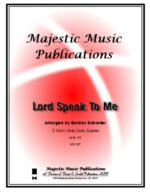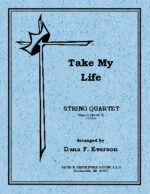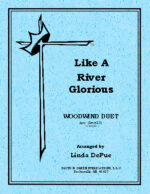-
Prelude on “Beethoven”
$29.95Though the historical background for the hymn tune “Beethoven” seems nebulous, it has been effectively paired with many hymn texts. Here, the composer’s Prelude is based on the thought-provoking text by Frances Ridley Havergal (1836-1879), “Lord, speak to me that I may speak.”
Prelude on “Beethoven” includes settings of two verses. The first instance utilizes the first verse of Havergal’s text in a sensitive, somewhat pastoral fashion, which is introduced by the composer’s original melodic material. The second setting, based on verse seven, reflects the climactic nature of the text.
Verse 1
Lord, speak to me, that I may speak in living echoes of Thy tone.
As Thou hast sought, so let me seek Thy erring children lost and lone.Verse 7
O use me, Lord, use even me, Just as Thou wilt and when and where,
Until Thy blessed face I see, Thy Rest, Thy joy, Thy glory share. -
-
-
-
-
-
I Gave My Life For Thee
$4.95A violin solo with piano accompaniment begins with a reflective motif. The violin makes an initial statement of the theme incorporating many double stops for harmonic and colorful shadings, all the while the accompaniment supporting with almost harp-like motions. This leads into an exuberant display of movement and bowing technics The second section continues in much the same manner all the while giving a serene sense until the piece comes to complete rest.
-
Take My Life, And Let It Be
$9.00This quartet starts out with imitative voicing and then yieilds to a cello solo line. After a brief transition to a new key the lower voices give way to melodic material only to be answered by the violins in duet form. The third section features the first violin with light accompaniment in the lower voices and then explodes to a sense of finality. Then, rests in a sense of submission.
-
Like A River Glorious
$4.50This is a violin solo that begins in a flowing manner and quickly accelerates to a more technical rendition of the tune creating a delightful atmosphere of this grand old hymn. It is effervescent and uplifting.
-
-
Like A River Glorious
$12.00This quintet (opt. Sextet) begins with extraneous motifs leading into the first statement of the theme in the low brass offset by answering material in the trumpets. The pieces continues in this question and answer texture passing motivic material around the parts. Then in a transition mimicking the beginning a modulation takes place where the theme is more expressive and becomes more aggressive leading up to a majestic coda where it ends on a thought-provoking conclusion.
-
Like A River Glorious
$4.00This French horn solo, written in a majestic style, opens with a declamatory statement of the hymn. It then uses fanfare-like figures to further embellish the melody’s statement. It ends on a strong note, giving a sense of confidence.
-
Like A River Glorious
$7.00This woodwind duet would be useful as a special presentation in a service. The nature of the work portrays great joy, variety, and dimension. The conclusive sections are deliberate and strong.
-
Like A River Glorious
$7.00This saxophone duet would be useful as a special presentation in a service. The nature of the work portrays great joy, variety, and dimension. The conclusive sections are deliberate and strong.
-
Like A River Glorious
$7.00This clarinet duet would be useful as a special presentation in a service. The nature of the work portrays great joy, variety, and dimension. The conclusive sections are deliberate and strong.
-
Like A River Glorious
$4.50This is a clarinet solo that begins in a flowing manner and quickly accelerates to a more technical rendition of the tune creating a delightful atmosphere of this grand old hymn. It is effervescent and uplifting.
-
Like A River Glorious (acc)
$7.00This flute duet would be useful as a special presentation in a service. The nature of the work portrays great joy, variety, and dimension. The conclusive sections are deliberate and strong.
-
Like A River Glorious
$4.50This is a flute solo that begins in a flowing manner and quickly accelerates to a more technical rendition of the tune creating a delightful atmosphere of this grand old hymn. It is effervescent and uplifting.






















